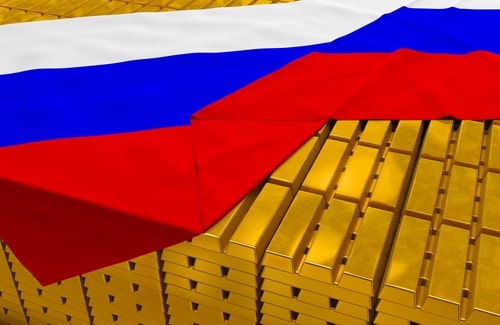
Formidable Western control over mainstream media have muted the news that the Russian central bank has announced that it will restart buying gold from banks at a fixed price of 5,000 roubles ($52) per gram between March 28 and June 30. This price is lower than the current market value of around $68.
Political commentator Hal Turner observed that the Russian move is the political equivalent of a nuclear explosion. He said that there are 32 grams per TROY ounce. The conversion rate of Rubles to US Dollars is 100 Rubles, 90 Kopecs, per US Dollar. Rubles bound to Gold at 5000 Rubles per gram means one ounce of gold would cost 160,000 Rubles. Converted to US Dollars means Gold is $1600/ounce when using Rubles, as opposed to $1,928/ounce using Dollars. This will cause a nearly thirty percent (30%) loss to the US Dollar, worldwide, in the matter of Gold Bullion.
Russia has already decided to sell its oil and gas in Rubles (price fixed at 5,000 Rubles per gram of gold). Thus, buyers can purchase Oil or Gas in Rubles or in Gold. But they will not get the US Dollar value for gold tendered as payment. The move is expected to create a surge in demand for the Ruble and the dumping of Dollars and Euros.
The impact is being watched carefully in financial markets across the globe. Libyan ruler Muammar Gaddafi tried to promote a gold-backed currency and was attacked by NATO. Given President Vladimir Putin’s challenge to the supremacy of the US Dollar and Euro, there will be turmoil in financial markets all over the world.
Turner expects foreign countries holding American Dollar Debt Notes in Reserve to begin to dump them and buy something with value, such as the Ruble. As a corollary, when the Dollar Reserves return to American shores, the US will suffer the worst hyper-inflation. Perhaps this is what drove President Biden to call for regime change in Moscow.
President Putin in a statement said Western Nations have STOLEN Russia’s foreign currency reserves and Gold Bullion Reserves, thereby shattering trust in so-called “First-Class” safety of investing in the West. Putin predicted that people would dump their holdings of Dollars and Euros and turn towards land, food, and raw materials for investment. As the US has moved all its local manufacturing offshore, it is only a matter of time when foreign countries stop accepting the dollar for payment; America will then be hit by shortages of everything.
The Bank of Russia had halted purchases in mid-March due to a surge in demand from households and to ensure adequate supply of gold for local buyers; renewed buying will ensure sustainable supply and continuous production of local gold. Russians raced to buy gold to protect their savings as the ruble collapsed. Moscow stimulated demand by scrapping a 20% value-added tax on purchases of metals. According to Sberbank, Russia’s largest financial institution, demand for gold and palladium quadrupled in the past few weeks, and Russia’s Ministry of Finance called gold an “ideal alternative” to the US dollar.
During the “gold standard” years (1879 to 1914) one ounce of gold was equal to $21. In the 1930s, Washington banned gold ownership by private citizens and raised the value of the dollar in gold from $20.67 to $35 per ounce. Then, in 1971, Richard Nixon ended the US dollar’s convertibility into gold; countries could no longer redeem dollars for gold. The gold standard was scrapped altogether in 1973.
By linking the ruble directly to the value of gold, Russia will get funding and manage its central bank financing outside of the US dollar system, as gold is the best international currency to use when seeking to get around sanctions. Previously, the US Treasury banned all gold transactions with Russia’s central bank.
In response to Western sanction following its action in Ukraine, Moscow announced that “unfriendly” countries would have to buy Russian gas in rubles or gold, Pavel Zavalny, chair of Russia’s Duma Committee on energy, said Russia is considering accepting Bitcoin for its oil and gas exports and being flexible with “friendly” countries, such as rubles and yuan with China and lira and rubles with Turkey.
Russia assiduously purchased gold over the last decade, as the best hedge against tough economic times. However, its central bank lost access to almost half of its foreign-currency reserves after Washington imposed an asset freeze. It can access reserves in gold and yuan, but sanctions impede the central bank from trading in gold.
Russia announced several measures to curb the ruble’s slide; raising interest rates to 20%, temporarily banning banks from selling cash currency to citizens who don’t already have foreign exchange accounts, and limiting transfers abroad. Nevertheless, the currency lost one- third of its value and triggered Russia’s biggest inflation spikes in this century.
References:
https://www.reuters.com/business/finance/russsian-cenbank-restart-buying-gold-banks-will-pay-fixed-price-march-28-2022-03-25/
https://www.kitco.com/news/2022-03-28/Russia-sets-fixed-gold-price-as-it-restarts-official-bullion-purchases.html
https://www.bloomberg.com/news/articles/2022-03-15/russians-buy-up-gold-to-salvage-savings-after-ruble-collapses
https://halturnerradioshow.com/index.php/en/news-pagur/newsite/world/it-s-official-russia-central-bank-announced-ruble-bond-to-gold-5000-rubles-per-gram






Add comment